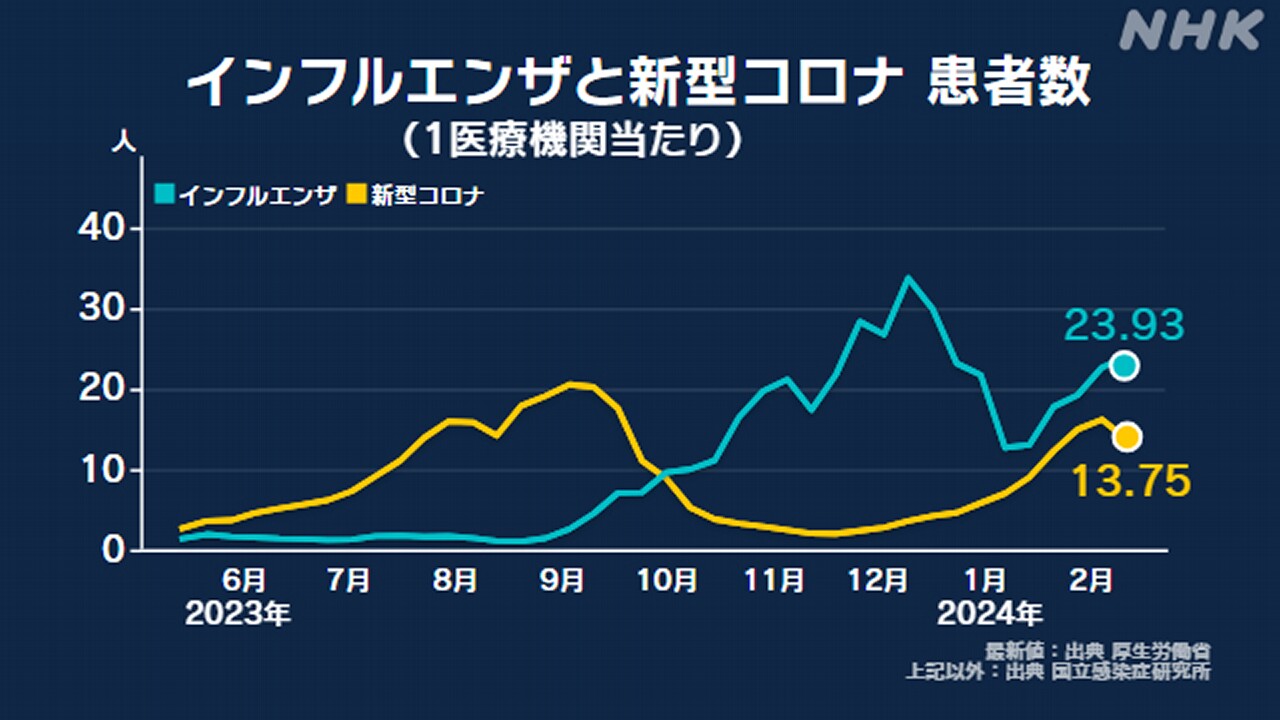The number of influenza patients reported by medical institutions nationwide was 23.93 per medical institution in the week ending February 11, an increase of 1.31 from the previous week. In seven prefectures, including Fukuoka Prefecture, the number of cases has exceeded the "warning level" of 30, and in 32 prefectures the number has increased from the previous week.
In addition, regarding the nationwide infection status of the new coronavirus, the average number of patients per medical institution was 13.75 in the week ending February 11, an increase of 0.85 times from the previous week.
Let's look at each situation in detail.
Influenza Number of patients per medical institution increased from the previous week
According to the National Institute of Infectious Diseases, the number of influenza patients reported from approximately 5,000 medical institutions nationwide in the week ending February 11 was 117,652, which was 23.93 per medical institution. There were 1.31 more people than last week.
Based on the data, the number of patients nationwide in the past week is estimated to be approximately 756,000, and the cumulative number of patients this season since September 4 of last year is estimated to be approximately 14,338,000.
Looking at the number of patients per medical institution by prefecture, Fukuoka prefecture had the highest number of patients at 56.48, followed by Saga at 38.15, Kumamoto at 34.83, and seven prefectures exceeded the "alert level" of 30. Ta.
In addition, 37 prefectures have reached the "advisory level" with more than 10 cases, including Osaka Prefecture with 29.56 cases, Aichi Prefecture with 29.55 cases, and Tokyo with 22.83 cases.
Compared to the previous week, the number of cases increased in 32 prefectures, including 1.55 times in Aomori Prefecture, 1.46 times in Hokkaido, and 1.39 times in Ishikawa Prefecture, and the increasing trend continues nationwide.
New Corona: Number of patients per medical institution is decreasing, but cancellation is necessary
According to the Ministry of Health, Labor and Welfare, the number of new coronavirus patients reported by approximately 5,000 medical institutions nationwide in the week ending February 11th decreased by 11,991 from the previous week to 67,614.
Additionally, the average number of patients per medical institution was 13.75, an increase of 0.85 times from the previous week.
By prefecture, Ishikawa prefecture had 21.91 cases, Aichi prefecture had 20.06 cases, Gunma prefecture had 19.89 cases, Ibaraki prefecture had 19.7 cases, and Fukushima prefecture had 19.18 cases, resulting in a decrease from the previous week in 41 prefectures.
Among these, Ishikawa Prefecture has a high number of new coronavirus patients, although reports from two locations in northern Noto are not included among the 48 medical institutions that are supposed to report the number of new coronavirus patients due to the impact of the Noto Peninsula earthquake. It has become standard.
Additionally, in the week ending February 11, the number of newly hospitalized patients reported by approximately 500 medical institutions nationwide was 3,257, a decrease of 204 patients compared to the previous week.
Regarding the nationwide epidemic situation, the Ministry of Health, Labor and Welfare said, ``It has started to decline for the first time since mid-November, and when looking at each prefecture, it has decreased in most prefectures, but we need to keep an eye on whether this trend will continue.We will continue to implement infection control measures. I hope that this will continue.''
"Continue to take thorough preventive measures"
Atsuro Hamada, a specially-appointed professor at Tokyo Medical University who is an expert on infectious diseases, said, ``Although the number of influenza patients is increasing due to the spread of the ``type B'' virus, the pace is slowing down, and it seems likely that it will reach its peak soon. However, there is a possibility that the virus will continue to spread for some time to come, so we need to continue taking preventive measures such as washing our hands and ensuring good ventilation."
Regarding the current state of the spread of the new coronavirus, he said, ``Judging by the number of patients, it may have peaked, but looking at the age, the decline is slow in elderly people who are more likely to become seriously ill, so we need to continue to be careful.'' ``JN.1,'' a type of Omicron strain that is slightly more infectious than conventional viruses and has a higher ability to evade immunity from past infections and vaccines, is spreading. We need to monitor the trend for another week or two.''
``While the epidemic continues, I would like people to strengthen their preventive measures.In addition to washing their hands frequently and ventilating their area, if you are feeling unwell, please consider that you may have been infected with the virus and stay at home.'' "I would like elderly people or those with persistent symptoms to seek medical attention as soon as possible while receiving medical treatment."

